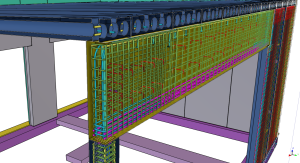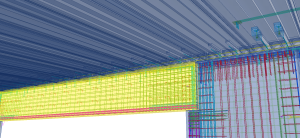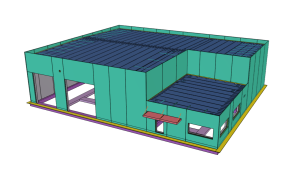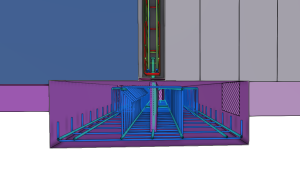Lagerbygg Moskog

| Category | Small Scale Projects |
|---|---|
| Year | 2024 |
| Country | Poland |
| Organization | Constravia |
| Author | Constravia |
| Place of construction | Moskog, Norwegia |
| Tags | PrefabConcreteTekla Structures |
Lagerbygg Moskog jest budynkiem magazynowym z częścią ładunkową i zapleczem biurowym. Mimo niewielkiej (~650m2) powierzchni ma trzy strefy pożarowe, w tym ściany wydzielenia w klasie R120.
Główną konstrukcję nośną zaprojektowano z wysokich na ponad 7m ścian sandwichowych w wersji z żebrami i bez. Dach zaprojektowano z płyt kanałowych o rozpiętościach dochodzących do ponad 11m. Ze względu na dużą wysokość kondygnacji i znaczną rozpiętość stropu konieczne było zapewnienie współpracy kilku płyt kanałowych dla poprzecznej stabilizacji ścian szczytowych od obciążeń poziomych. Odpowiedzialnym elementem jest blisko 10m długości belka podpierająca strop obu naw budynku. Zamówienie objęło także projekt fundamentów podpór tymczasowych. Termin realizacji projektu był bardzo krótki, bez zapasów czasowych między projektowaniem a produkcją elementów w fabryce i ich montażem na budowie.
Do tworzenia modelu i rysunków korzystaliśmy z oprogramowania Tekla Structures. Dzięki elastyczności tego programu wykorzystywaliśmy zarówno komponenty wbudowane w Teklę, jak i autorskie. Dzięki temu wiele procesów zostało zautomatyzowanych.
Lagerbygg Moskog is a warehouse building with a cargo area and office facilities. Despite its small (~650m2) area, it has three fire zones, including R120-class separation walls.
The main load-bearing structure is designed with more than 7m high sandwich walls, in versions with and without ribs. The roof was designed from hollow core slabs with spans reaching over 11m. Due to the large height of the floors and the significant span of the ceiling, it was necessary to ensure the cooperation of several hollow core slabs for lateral stabilization of the gable walls from horizontal loads. The key element is a nearly 10m-long beam supporting the ceiling of both aisles of the building. The order also included the design of the foundations of the temporary supports. The project deadline was very short, with no time reserves between the design and the production of the elements in the factory and their installation on site.
We used Tekla Structures software to create the model and drawings. Thanks to the flexibility of this program, we used both Tekla’s built-in and proprietary components. As a result, many processes were automated.






